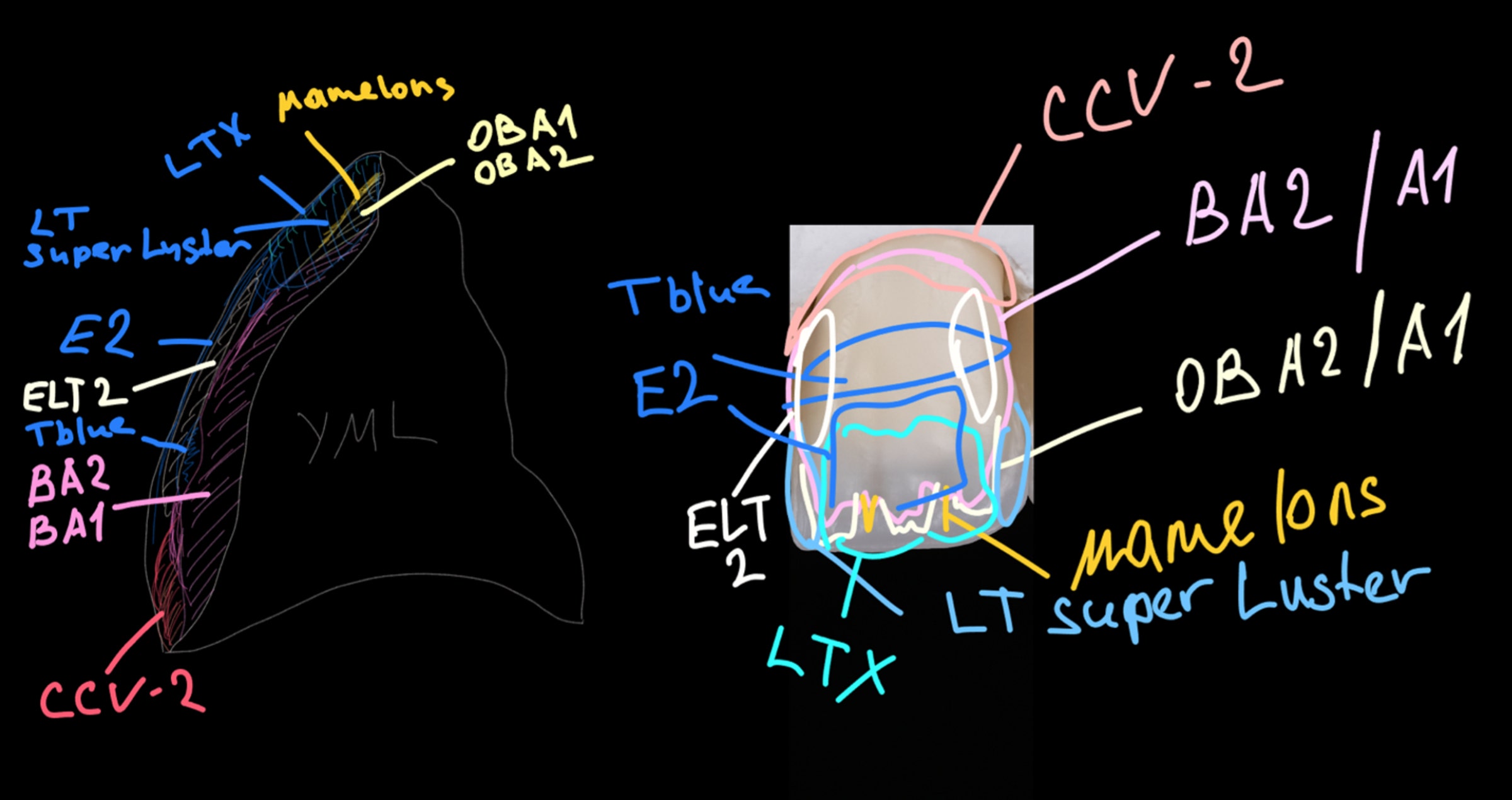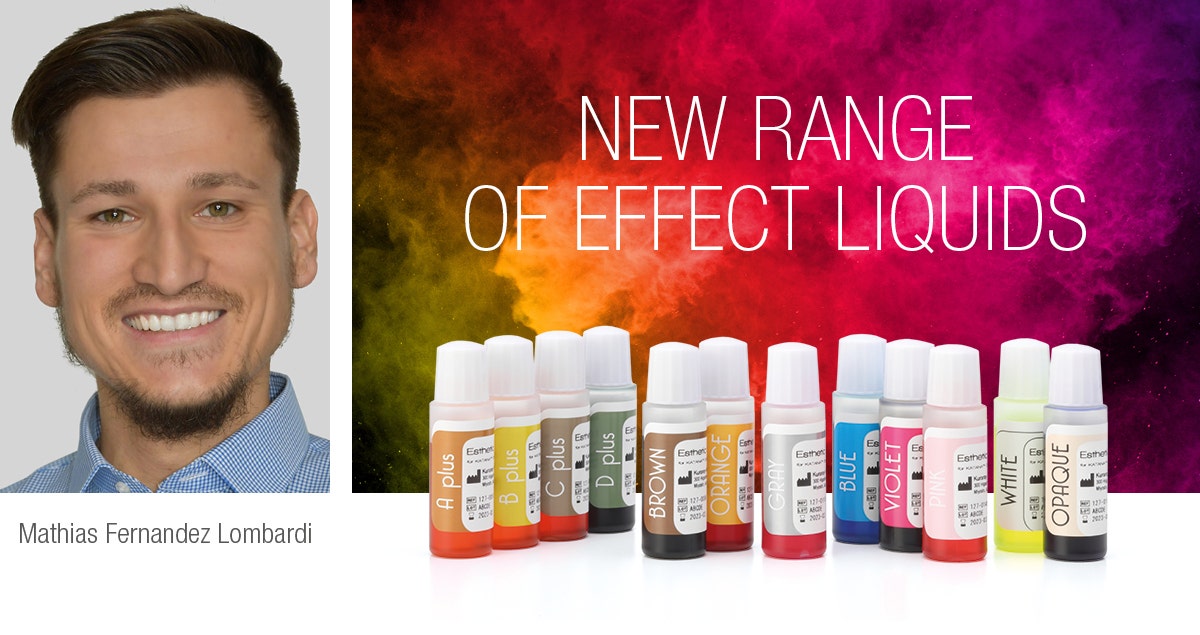
Esthetic Colorant, the new range of effect liquids from Kuraray Noritake Dental Inc.
Interview with Mathias Fernandez Lombardi.
Now even more colour intensity for lifelike zirconia restorations
In autumn 2022, Kuraray Noritake Dental Inc. announced the launch of Esthetic Colorant for KATANA™ Zirconia. This marks the company’s next milestone in the field of innovative dental zirconia. The goal of producing restorations with a deceptively real look is achieved almost effortlessly with the new effect liquids form the Esthetic Colorant portfolio. Mathias Fernandez Lombardi is a trained dental technician, studied dental technologist and is Lab & CAD/CAM business group leader at Kuraray Europe GmbH. In an interview with Annett Kieschnick, he elaborates on the unique features of Esthetic Colorant.
What exactly is Esthetic Colorant?
Mathias Fernandez Lombardi: Esthetic Colorant is a range of effect liquids used for shading and characterization of pre-sintered zirconia structures. This new portfolio is a fantastic asset for dental laboratories and milling centres. The product range is designed for the KATANA™ Zirconia Multi-Layered Series. Products have been aligned to produce exactly the desired shades when sintering in the dental laboratory (final sintering temperature). As Esthetic Colorant is used with pre-shaded zirconia, the product range does not include any basic shades, such as the shade A2 or A3. We know this from the dyeing liquids offered by other manufacturers. However, Esthetic Colorant is different, for example, its colour saturation is intentionally less intensive.

The effect liquids Esthetic Colorant breathe life into zirconia restorations before sintering. In contrast to classic dyeing liquids, Esthetic Colorant is specifically designed for aesthetic zirconia (KATANA™ Zirconia Multi-Layered) and gives a lifelike effect to the restoration.
The shading or infiltration of zirconia prior to sintering is something known from “the past”. Isn’t this technique history? Why launch a “new edition” of this technique?
Mathias Fernandez Lombardi: This new edition is fundamentally different. Esthetic Colorant should not be confused with classic dyeing liquids "from the past". The traditional liquids were used to provide “white” zirconia with a highly saturated colour. By contrast, Esthetic Colorant is an intentionally less saturated effect liquid for multi-layered zirconia. When applied, the liquids allow the highly aesthetic zirconia to “breathe” and fully develop its translucency. The idea behind it is as ingenious as the product range itself. Esthetic Colorant provides for a kind of lifelike characterization of the restoration in the pre-sintered state. It is perfected for modern, highly translucent zirconia, so that individual, case-specific effects are created even before the final sintering procedure.
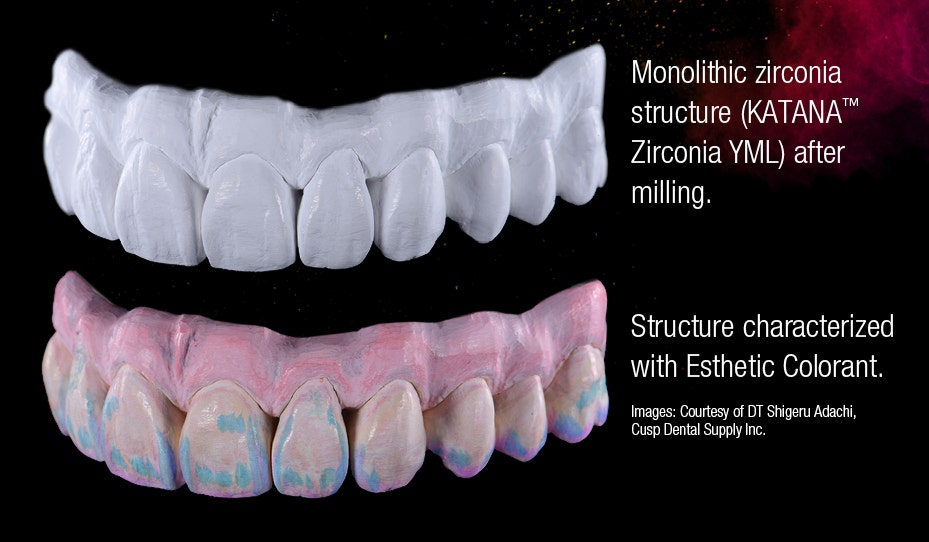
Why is it useful to characterize an already pre-shaded zirconia with such a high colour fidelity as KATANA™ Zirconia with effect liquids before sintering? Is this process necessary?
Mathias Fernandez Lombardi: Dental technicians are familiar with the great challenge of imitating natural teeth. Every tooth has its unique internal colour structure and reproducing this structure in the conventional way (using a ceramic layering technique) requires a great deal of experience, sensitivity and, above all, time. By contrast, achieving a vivid reconstruction of the tooth’s internal colour structure with a monolithic restoration characterized with external stains only is barely possible. The procedure is efficient, but colour is only applied to the outer surface. In this way, the reproduction of a natural tooth’s three-dimensional colour effects and internal details is very limited. Esthetic Colorant, which was specifically developed for the KATANA™ Zirconia Multi-Layered series, paves the way for a new approach. KATANA™ Zirconia features a unique (patented (EP2024300)) raw material technology and a specific colour structure. Even without additional shading, staining or dyeing, highly aesthetic results can be obtained. With Esthetic Colorant, it is now possible to reproduce even the multitude of internal colour properties of a tooth in an easy and efficient way. Even in monolithic restorations, depth effects are created, which come very close to those of a layered restoration. To sum up, Esthetic Colorant enhances the aesthetic power of KATANA™ Zirconia.
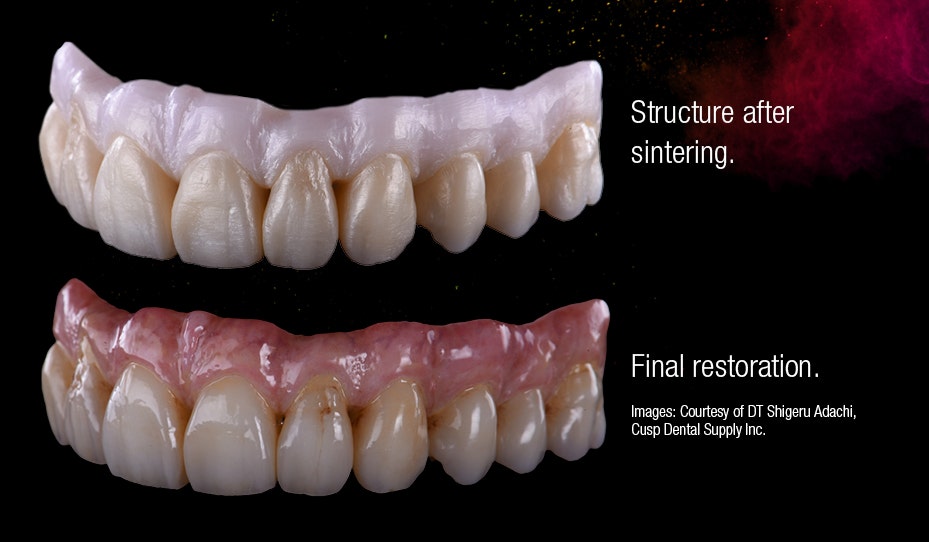
*Final restoration. Stains used for finishing: CZR PRESS LF External Stains: Salmon Pink, Red, Blue. CERABIEN™ ZR FC Stains: A+, Blue, Mamelon Orange 2, Cervical 1, Reddish Brown, White, Clear Glaze.
Characterizing before sintering versus individualizing with stains – do users need to decide between those two techniques? Which is the better way? Or is it possible to combine the techniques?
Mathias Fernandez Lombardi: Each dental laboratory needs to find out the "best" way for itself. For example, there is simply no way for laboratories that have outsourced the milling and sintering steps of dental zirconia to characterize the frameworks in the pre-sintered state. They can use internal stains, veneering porcelains or external stains for an aesthetic finalization. Those laboratories milling and / or sintering their zirconia structures in-house, however, may choose between different approaches to add the “final touch”. It is possible to combine different methods of complementary shading without any problems. For example, it is possible to add the desired effects to the zirconia framework with Esthetic Colorant in the pre-sintered state. After sintering, finishing of this restoration may be accomplished with a porcelain system such as CERABIEN™ ZR. Esthetic Colorant is also ideally suited for monolithic or zero-cut-back restorations. In this case, various colour effects are added to the structure already before sintering. This will lead to three-dimensional depth effects in the restoration. In addition, fine adjustments can be made with external stains or glaze (like CERABIEN™ ZR FC Paste Stain) whenever desired. If ceramic firing is not required, the restoration treated with Esthetic Colorant may be finished by polishing after sintering.
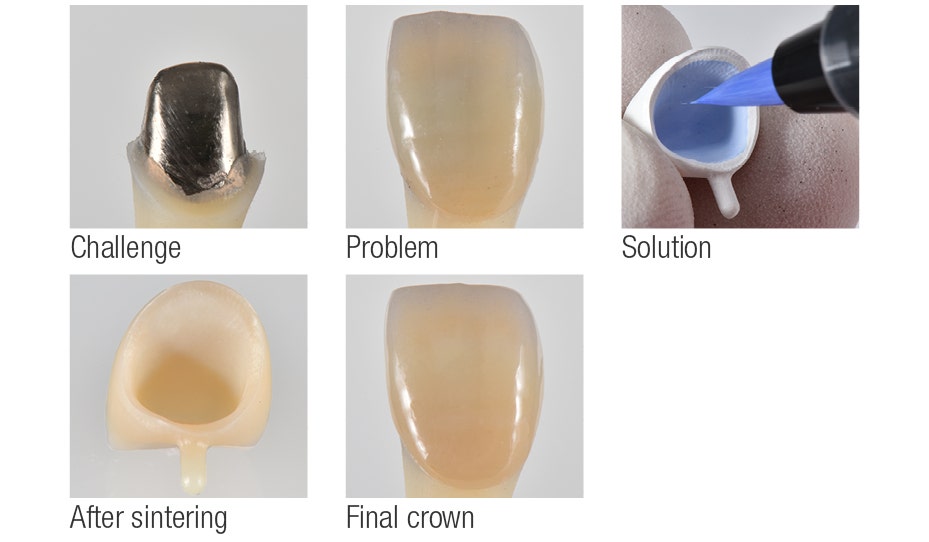
*Challenge: An all-ceramic crown is planned to restore the metal abutment.
*Problem: Zirconia crown before the application of Esthetic Colorant. The abutment shines through and has a strongly negative effect on the aesthetics.
*Solution: The intaglio of the zirconia crown is treated with Esthetic Colorant WHITE or OPAQUE before sintering.
*After sintering: Esthetic Colorant blocks the abutment colour from the inside.
*Final crown: (KATANA™ Zirconia YML and Esthetic Colorant OPAQUE). Masking of the metal abutment has been successful, and the natural translucency of the crown is maintained.
What are the mainly recommended areas of application for Esthetic Colorant?
Mathias Fernandez Lombardi: Apart from characterizing zirconia structures, there is one area of application that is worth highlighting as it noticeably facilitates everyday procedures in the dental laboratory: With Esthetic Colorant, it is possible to successfully mask discoloured abutment teeth, metal posts and cores and metal abutments (implant restorations). Especially in times with an ever-increasing translucency and aesthetic potential of dental zirconia, this aspect is highly relevant for everyday work. The more translucent a material is, the more light can pass through it, which will inevitably reveal any unwanted discolouration or the characteristic grey-silver colour of an abutment. Those negative effects can be prevented by using OPAQUE and WHITE from the Esthetic Colorant line-up. These special effect liquids are applied to the intaglio of the restoration prior to sintering. What happens now is really special and the chemistry behind it is unique. The liquids contain silane, which acts as a penetration blocker in the solution. Consequently, WHITE and OPAQUE block the discoloured or metal-coloured abutments on one side, while at the same time supporting the beautiful translucency of the zirconia.

Liquid Brush Pen for a convenient application of Esthetic Colorant.
How are the effect liquids applied? With a brush?
Mathias Fernandez Lombardi: It is theoretically possible to apply them with a brush, as long as it is a metal-free brush. We recommend the use of our “Liquid Brush Pen,” a pen specifically designed for Esthetic Colorant. It consists of three components: a tip with a lid, a main housing filled with the liquids and a dispenser, which ensures that the tip does not dry out. Due to its specific construction, a sufficient amount of – but never too much – effect liquid reaches the tip. In this way, the application if the liquids become extraordinarily easy with the Liquid Brush Pen. We recommend using a separate Liquid Brush Pen for every colour that is used more than once. This will speed up the procedure. To conclude, KATANATM Zirconia Multi-Layered, Esthetic Colorant and Liquid Brush Pen are a real dream team. They offer lifelike colours as desired by every dental technician.
Thank you for the interesting information about a truly special new product in the field of dental zirconia.
Annett Kieschnick

Mathias Fernandez Y Lombardi
EU Scientific Manager
Dental Ceramics & CAD/CAM Materials
Kuraray Europe GmbH
2013
Successful completion of an apprenticeship as a dental technician at Seuthe dental laboratory in Plettenberg, Germany
2018
Successful completion of dental technology studies at the University of Osnabrück, Germany. Graduation as an engineer in dental technology
Since March 2018
Employee of Kuraray Europe GmbH
- 28 de fev. de 2023






